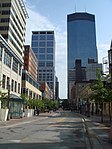Gaviidae Common

Gaviidae Common is a mixed-use shopping mall and office complex on Nicollet Mall in Minneapolis, Minnesota. The first phase of the mall, Gaviidae Common I, opened in 1989 and is adjoined to Gaviidae Common II by a series of skyways. Phase II opened in 1991. A joint venture designed by Argentine American architect César Pelli and Chicago-based Lohan Associates, the mall occupies 443,000-square-foot (41,000 m2) of retail and office space spread across five floors. Following the closure of the mall's food court and several tenants in 2013, the top three floors of Gaviidae Common II were converted into office and recreational space for the adjoining RBC Plaza. The mall houses the state's largest barrel-vaulted ceiling and contains loon-inspired artwork designed by Deborah Sussman and Paul Prejza. Loons belong to the family Gaviidae, hence the shopping center's namesake. Gaviidae Common is anchored by Walgreens and YMCA, both of which were added to the mall's lineup of stores after an extensive renovation of the shopping center. Saks Fifth Avenue, the mall's original anchor tenant, converted into a discount store in 2005, before closing in 2015. Neiman Marcus opened along with phase II in 1991 but closed in 2013.
Excerpt from the Wikipedia article Gaviidae Common (License: CC BY-SA 3.0, Authors, Images).Gaviidae Common
Nicollet Mall, Minneapolis
Geographical coordinates (GPS) Address Nearby Places Show on map
Geographical coordinates (GPS)
| Latitude | Longitude |
|---|---|
| N 44.977222222222 ° | E -93.271388888889 ° |
Address
Gaviidae Common
Nicollet Mall
55402 Minneapolis
Minnesota, United States
Open on Google Maps






